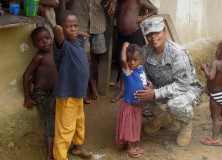The 2003 U.S. Intervention in Liberia — Henrik Bliddal

INTRODUCTION:
In the summer of 2003, Liberia was unraveling. Since an intermittent civil war began in 1989, Liberia had been the “eye of the regional storm” in West Africa. The conflict claimed over 200,000 lives, and eventually spilled over into neighboring states, most notably Sierra Leone and Côte d’Ivoire. The death toll continued to mount and the number of refugees and internally displaced persons was approaching 500,000. To stabilize the situation and counter a looming humanitarian disaster, the Bush administration participated in a limited intervention and supported Nigerian peacekeepers under the umbrella of the Economic Community of West African States (ECOWAS). In preparation for the intervention, the U.S. offered ECOWAS diplomatic, logistical and financial support and ordered the Iwo Jima Amphibious Ready Group to Liberia. In August, under Operation Sheltering Sky, about 200 of the 2,100 military personnel aboard the ready group deployed in Monrovia. The minimal American military operation ended on October 1, 2003 when the UN Mission in Liberia (UNMIL) assumed responsibility. In the eyes of Colonel Blair A. Ross, then Director of the Joint Staff, Joint Task Force Liberia, “the U.S. military mission in Liberia was an unqualified success.” The International Crisis Group (ICG), which had been otherwise critical of the U.S. approach to Liberia, likewise acknowledges that “The U.S. did play a useful role…” Today, according to the ICG, Liberia seems to be on a delicate path to peace: “Everything is aligned for potential success but the situation, as shown by the post-election riots [of 2005], remains fragile.”
STRATEGY:
During the crisis, major policy differences, mainly between the Departments of Defense and State, could not be resolved for over a month. This failure in the decision-making process led to an ad hoc approach to the Liberian humanitarian emergency. The deployment of a Humanitarian Assessment and Security Team was illustrative of this. The Team did little to help develop a strategy, as its initial report was blocked by the Pentagon for offering policy advice. A decision to endorse a small-scale U.S. intervention in support of a larger peacekeeping force manned by ECOWAS was eventually reached.
INTEGRATED ELEMENTS OF NATIONAL POWER:
Delayed decision-making did not translate into mission failure. Once a strategy was identified, the departments responsible for planning and implementing the operation exhibited a strong response characterized by good interagency coordination and situational awareness. As a result, the ad hoc intervention was a success.
EVALUATION:
Disinterest during the early stages of the crisis, lack of information sharing, long-term inattention to the Liberian situation and policy drift due to diverging preferences on a course of action were partially responsible for decision-making failure. However, once the mission was ordered, the response was highly effective. Early recognition of operational demands was central to mission success. Experience in coordinating humanitarian operations allowed the European Command to appreciate the complexity of interagency processes in such contingencies. Coupled with advanced technology, this recognition contributed to the mission’s success.
RESULTS:
The operation achieved all identified mission objectives: the intervention abated the humanitarian crisis, supported ECOWAS in securing Monrovia and paved the way for UN peacekeeping forces, thus putting Liberia on the road to peace. Nevertheless, decision-making gridlock led to unnecessary loss of life in Liberia; a wavering approach made it harder to convince regional players to assume the lead; and unwavering adherence to the mission statement resulted in a risky transition phase.
CONCLUSION:
The Liberia operation is an example of a successful U.S. intervention in Africa, where U.S. military engagement has been especially scarce since the ill-fated 1992-1993 Operation Restore Hope in Somalia. Major policy differences in the NSC resulted in early decision-making paralysis and an ad hoc approach to the Liberian crisis but this did not lead to a failure of the intervention. Instead, once the choice was made to intercede on a small scale, the proper resources were brought to bear and the operation achieved all the goals identified by the administration. The nature of the complex humanitarian operation and Liberia’s operational environment necessitated strong interagency efforts and lessons learned may facilitate the strengthening of the new African Command.